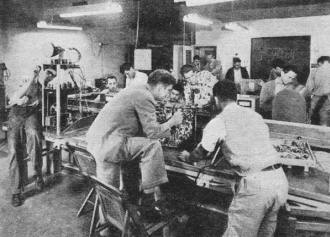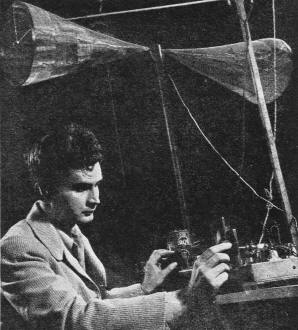|
I was surprised to not find
in this story any mention of military training as a possible pathway to a career
in electronics. 1948, when this article appeared in Radio & Television News
magazine, was a year when a plethora of highly trained and competent cadre of electronics
technicians were available for exploitation by commercial industries. During the
years of World War II, which came to a close in the Fall of 1945, most research,
development, and production of high tech equipment resulted in major advancements
in radio, television, radar, teletype, medicine, and creature comforts was operated
and maintained by service personnel. Immediately after the war and even for many
months prior to the surrenders of Germany and Japan, when the outcome became apparent,
many commercial companies began training programs for accommodating a new era of
technology for the civilian community.
Students of Today - Technicians of Tomorrow

Commercial video broadcast equipment at American Television.
Inc., includes the latest RCA image orthicon camera links as well as iconoscope
cameras for studio use by the trainees.
By Charles Edward Chapel
Many schools stand ready and equipped to help you get basic training in television.
Only the uninitiated will contend that television is a subject that "anyone can
pick up in his spare time." The complexity of modern television circuits, the high
voltages encountered, and the delicacy of many of the component parts puts television
out of the reach of the kitchen-table tinkerer or the casual experimenter. Television
is a job for trained men who know what they are doing and why. The cost of the equipment
alone, either at the transmission end or in the home, is such that the tyro is excluded
from servicing work. The test equipment used in the servicing and aligning of television
receivers is of laboratory caliber and, as such, needs the touch of the trained
man.
Of course, formal training in television is the only answer to the present problem
of securing enough qualified technicians to service the hundreds of thousands of
television sets already in use and to install the many thousands more receivers
coming off the production lines.
There are today in this country many well-equipped and fully-accredited schools
where embryo video technicians may acquire the necessary know-how to enable them
to competently service television receivers. Each of these schools offers many advantages
to the prospective student; trained faculty, well-equipped technical libraries,
modern laboratories and workshops where up-to-date test and servicing equipment
is available, in addition to employment placement services which assist the graduate
to find his niche.

Television studio and a partial view of the control room set
up at the Electronics Institute. Inc., in Detroit. Here students study some of the
practical problems encountered in TV.

Good laboratory equipment plays an important role in the training
of future television technicians. At Central Radio and Television Schools these
students check an RCA 630 TS receiver.

Students unable to attend resident schools have a wide choice
of correspondence courses. This DeForest Training, Inc., student can experiment
with radio equipment in his own home.

"Learning by doing" is one of the best ways to acquire a working
knowledge of television. Here students at the Hollywood Sound Institute test their
theoretical training in the lab.

The demand for television servicing courses is at an all-time
high. These students at Valparaiso Technical Institute work on commercially built
receivers in the school's laboratories.

This well-equipped technical library for students in residence
at Capitol Radio Engineering Institute in Washington points up one advantage of
formalized technical TV training.
Many of these schools offer both day and evening courses for the benefit of students
employed in other fields. Some of these courses are available to veterans under
the G.I. Bill while still other courses can be pursued at home through "home study"
or "correspondence" plans.
According to the catalogues of the schools, courses are varied in length or can
be tailored to suit the requirements of the student. Curricula cover from one year
to 6 year courses which qualify the student as a television serviceman or lead to
a degree of Bachelor of Science in Television Engineering.
Many factors will enter into the student's choice of educational facilities;
proximity to his home, length of course, type of training offered, availability
for veterans' training, etc. In making any selection it is well to remember that
the training received now will let you in on the ground floor of a new and growing
profession. Investigate the courses that the various schools have to offer. Discuss
your educational requirements with the registrars at the various schools.
Professional advice on the selection of the proper school to meet your needs
is available from Dr. J. S. Nofsinger, Director, National Council of Technical Schools,
Washington, D. C.
The thing to remember; however, is that the time is very near when thousands
of television technicians will be needed and what you do now toward getting adequate
training in the field will affect your future in television. The bandwagon is rolling
now - the decision is up to you!

Television antenna equipment is no mystery to the student who
can experiment with a variety of installations. American Television Laboratories
of California provides such facilities.

Control panels and other television studio equipment give students
at the National Schools an opportunity to test their video knowledge under simulated
TV transmission conditions.
Posted November 17, 2022
(updated from original
post on 10/3/2016)
|

















